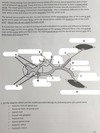Muscles and Nerves Flashcards
What are muscles that attach both to the axial and appendicular skeleton?
Appendicular muscles
How does muscle attach to bone?
Muscle attaches to bone by a tendon
What is the origin of a muscle?
The origin of a muscle is the proximal/supperior/medial attachment
What is the insertion of a muscle?
The insertion of a muscle is the distal/inferior/lateral attachment
At the bone, where are the fibres of a tendon embedded?
The fibres of a tendon at a bone are embedded within the periosteum
What is an aponeurosis?
An aponeurosis is the flat, thin and broad tendons of the abdominal oblique muscles
What happens when triceps contract?
When triceps contract they pull the elbow back (extends the joint)
What are diaphagm skeletal muscles?
Diaphagm skeletal muscles are ones which attach bones from either side of the midline of the sagittal plane
What is the purpose of the diaphragm?
The purpose of the diaphragm is to increase volume of the tharacic cavity during inspiration, descending on contraction and ascending on relaxation
What happens when the muscle fibres of the central tendon contract?
When the muscle fibres of the central tendon contracts the dome descends
What direction does the dome move on contraction?
The dome moves inferior on contraction
Why can muscles such as the deltoid perform many movements on the joint?
They have many fibres (anterior, middle and posterior) that can pull the shoulder joint in different directions
What is an antagonistic pair?
Antagonistic pairs are muscles that combine in an antagonistic way to carry out a particular action on a joint
What muscles are responsible for the arm flexing?
Anterior arm and forearm muscles are responsible for the arm flexing
What groups of muscles relax as you flex your elbow?
Posterior muscles relax as you flex your elbow
What is the agonist muscle?
The agonist muscle is the one that produces the motion
What is the antagonist muscle?
The antagonist muscle is the one that opposes the action
What is a synergist?
A synergist assists the agonist by helping to perform the same set of joint movement
What is an example of stabalising muscles?
An example of stabalising muscles are the rotaror cuff muscles around the shoulder, they reduce the risk of dislocation
What does muscle testing allow?
Muscle testing allows the diagnosis of both muscle and nerve injuries by assesing the power of movement
What is muscle atrophy?
Muscle atrophy is the wasting of muscle tissue
What is an example of a muscle that crosses two joints and performs a different movement on each?
The hamstring is an example of a muscle that crosses two joints and performs a different movement on each
What can muscles be compartmentalised by?
Muscles can be compartmentalised by:
- Deep fiscial intermuscular septa which seperates them into compartments
- Common nerves supplying all the muscles in a compartment
- Common actions of the muscles in a compartment
What is A?

Intermuscular septum











































